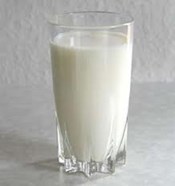June is National Dairy Month. Dairy is among the foods highlighted last week when the U.S. Department of Agriculture released its new MyPlate icon. The new MyPlate icon replaced the long familiar food pyramid and provides guidance to help consumers make healthy food choices.
The USDA guidance suggests switching to fat-free or low-fat (1 percent) milk. To that end the USDA offers 10 tips to help you eat and drink more fat-free or low-fat dairy foods.
The USDA recommends 3 cups daily of milk or milk products for those 9 years and older and 2 cups daily for ages 2-8. “In general, 1 cup of milk, yogurt, or soymilk (soy beverage), 1 ½ ounces of natural cheese, or 2 ounces of processed cheese can be considered as 1 cup from the dairy group,” the USDA’s ChooseMyPlate.gov website says.
Here are the USDA’s tips to eat and eat more fat-free or low-fat dairy:
1) Drink skim
Drink fat-free (skim) or low-fat (1%) milk. If you currently drink whole milk, gradually switch to lower fat versions.
2. Boost potassium and vitamin D, and cut sodium
Choose fat-free or low-fat milk or yogurt more often than cheese. Milk and yogurt have more potassium and less sodium than most cheeses. Also, almost all milk and many yogurts are fortified with vitamin D.
3. Top off your meals
Use fat-free or low-fat milk on cereal and oatmeal. Top fruit salads and baked potatoes with low-fat yogurt instead of higher fat toppings such as sour cream.
4. Choose cheeses with less fat
Many cheeses are high in saturated fat. Look for “reduced-fat” or “low-fat” on the label. Try different brands or types to find the one that you like.
5) What about cream cheese?
Regular cream cheese, cream, and butter are not part of the dairy food group. They are high in saturated fat and have little or no calcium.
6) Switch Ingredients
When recipes such as dips call for sour cream, substitute plain yogurt. Use fat-free evaporated milk instead of cream, and try ricotta cheese as a substitute for cream cheese.
7) Choose sweet dairy foods with care
Flavored milks, fruit yogurts, frozen yogurt, and puddings can contain a lot of added sugars. These added sugars are empty calories. You need the nutrients in dairy foods—not these empty calories.
8) Caffeinating?
If so, get your calcium along with your morning caffeine boost. Make or order coffee, a latte, or cappuccino with fat-free or low-fat milk.
9) Lactose Intolerant?
Try lactose-free milk, drink smaller amounts of milk at a time, or try soymilk (soy beverage). Check the Nutrition Facts label to be sure your soymilk has about 300 mg of calcium. Calcium in some leafy greens is well absorbed, but eating several cups each day to meet calcium needs may be unrealistic.
10) Take care of yourself and your family
Parents who drink milk and eat dairy foods show their kids that it is important. Dairy foods are especially important to build the growing bones of kids and teens. Routinely include low-fat or fat-free dairy foods with meals and snacks—for everyone’s benefit.







